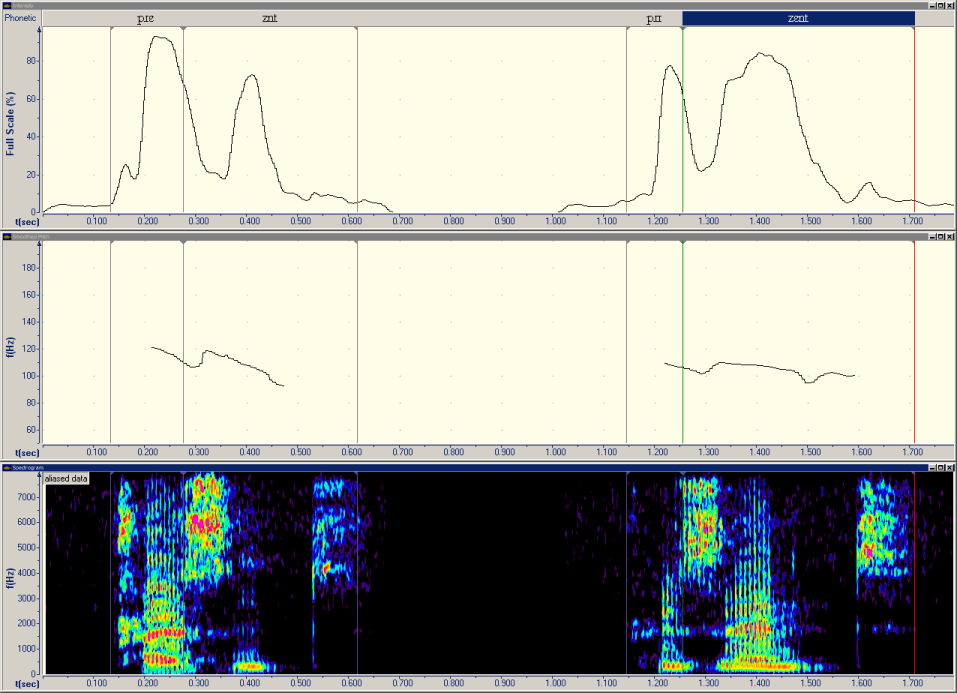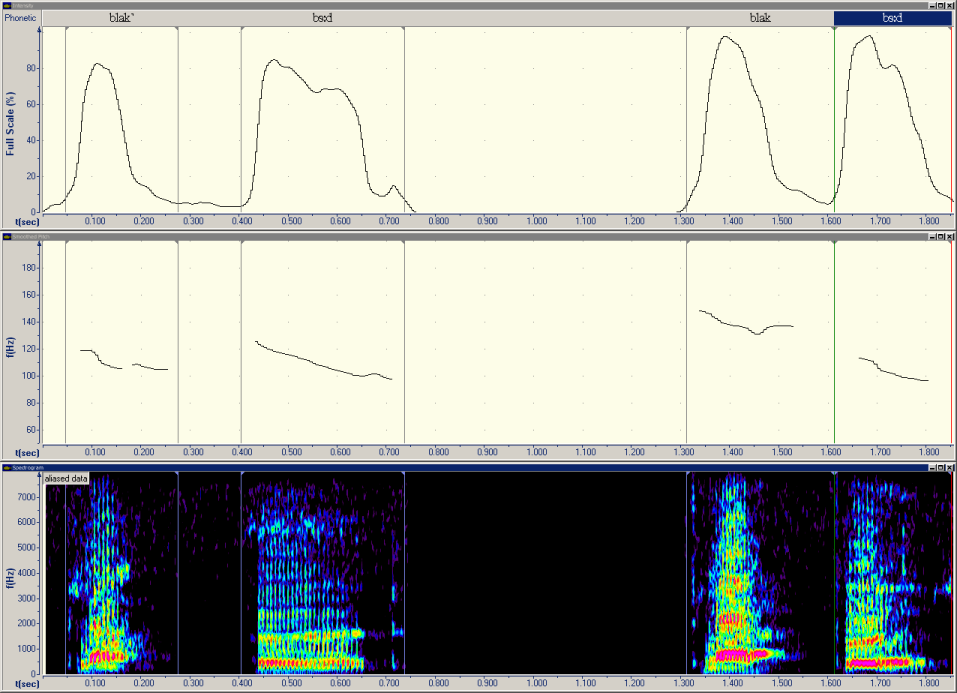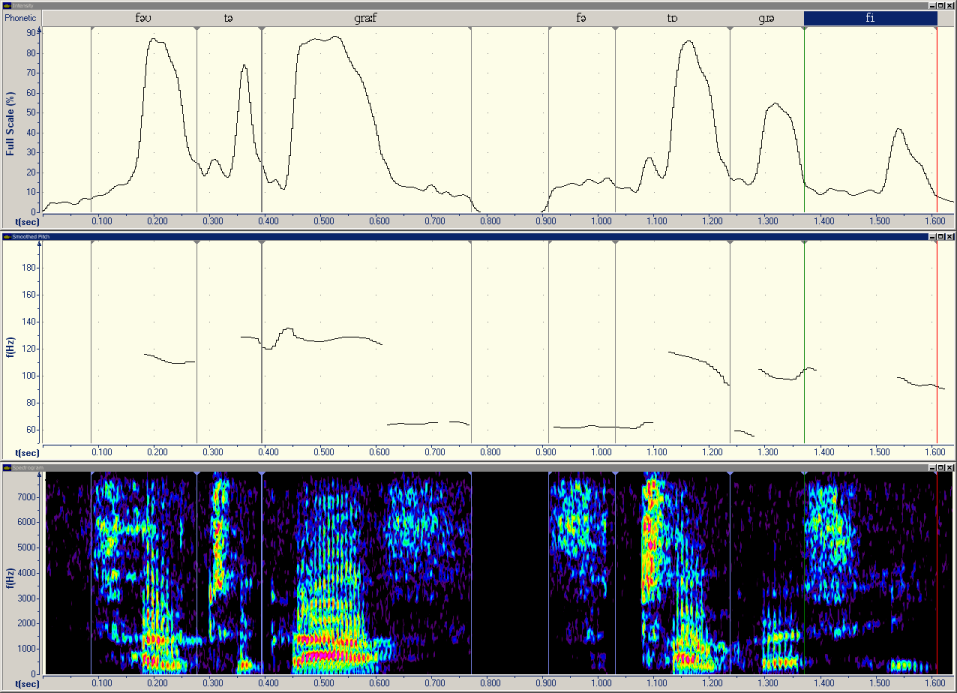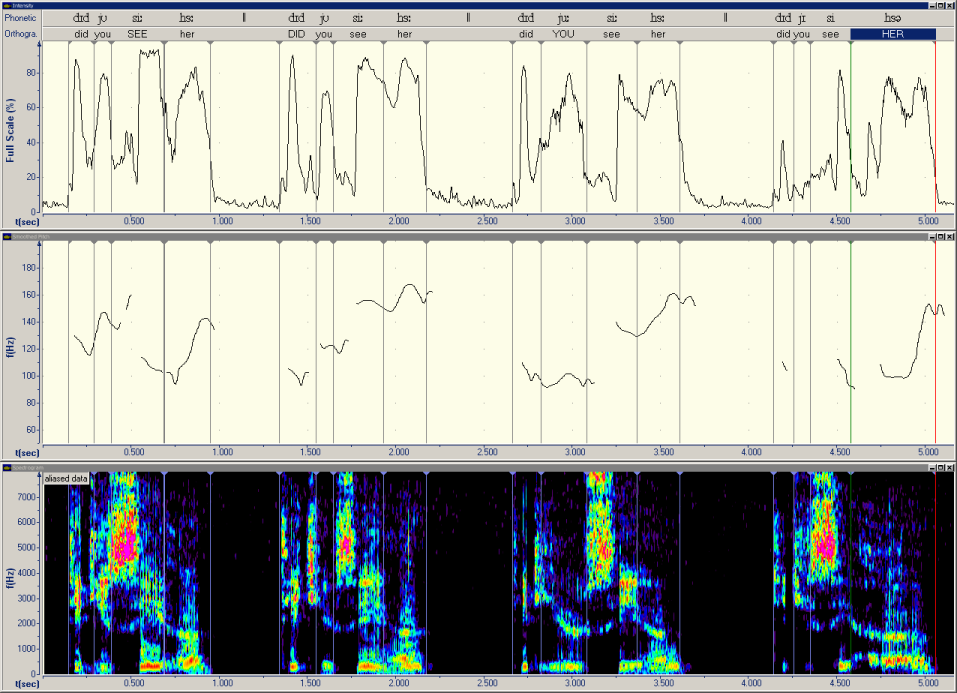


Word stress is a feature used to give prominence to one or more syllables within a word. Usually, this is the type of prominence we tend to apply to words produced in isolation, as we find them in a dictionary. Most approaches to word stress distinguish between three possible levels:
The impression of stress is not usually due to a simple feature of higher intensity of the relevant syllable, but is often caused by a combination of pitch movement, length of the vowel at the core of the syllable, and intensity, rather than by any one of these three features in isolation. Intensity actually seems to play the weakest role in creating the impression of prominence, pitch the strongest, length occupying the ‘middle ground’.
Word stress may be used distinctively in English in three different ways, which will be illustrated below, including possible interpretations of the effects responsible for the impression of stress in each case.
We can employ stress to disambiguate between grammatically polysemous words, i.e. where we have cases of different pronunciations depending on whether the word is (in most cases) a noun or a verb, as in present (n.) /ˈprɛznt/ vs. present (v.) /prɪˈzɛnt/.

We can clearly distinguish a difference in the patterns here. In the noun, we clearly have a peak of higher intensity on the first syllable, whereas the peak on the second syllable in the verb is not quite as distinct, probably because the first syllable contains a reduced vowel, while the vowel in the second syllable of the noun is completely elided, which also makes the noun shorter. As far as the pitch is concerned, there seems to be a clearer continued fall throughout the noun, although there is a kind of odd reset inside the voiced fricative. In the verb, there is a rise towards the accented vowel in the second syllable, with a relatively steady downdrift following it. The slight dip towards the end of the contour may be due to the stronger release of the final voiceless plosive that may have triggered another rise in pitch.
Stress can be used to help distinguish adjective-noun pairs and compounds, such as e.g. black bird (2 words) /ˈblakˈbɜ:d/ vs. blackbird (compound) /ˈblakbɜ:d/, when they occur in isolation or form complete noun phrases.

Again, we can observe clear differences in the two patterns. The adjective-noun pair shows a clearer pause between the two words, whereas the period of relative silence in the compound is most likely only due to the release phase of the voiceless consonant in the first part and the consecutive plosure phase preceding the voiced consonant at the beginning of the second part. The second syllable in the first sample is also clearly longer than in the compound, where it seems relatively compressed and both syllables are of similar length. The adjective-noun pair also exhibits a clear pitch reset at the beginning of the second word, while the pitch contour for the compound is again a relatively steady falling one, with only a slight rise in between, which may again be an artefact caused by the voiceless plosive. The main peaks of intensity for both examples are at approximately the same height for both syllables, so that intensity clearly does not seem to be the distinguishing factor.
Stress can mark certain derivational effects, primarily caused by the addition of specific (but certainly not all) suffixes, such as in photograph /ˈfəʊtəgɹɑ:f/ vs. photography /fəˈtɒgɹəfi/.

Here, we can recognise that there are two distinct peaks of intensity on the first and third syllable in the first noun, whereas there is only one on the second syllable in the derived noun, despite the addition of another syllable. The second peak in the first word is due to the strength of the long vowel at the peak of that syllable, but the unusually high pitch on the same syllable seems to be caused by my reading the word almost as if it were a list item and would probably not occur if the word were read completely in isolation. Although I could have simply re-recorded the word, I have deliberately left it this way in order to demonstrate problems of this type. In the second word, the pitch movement begins on the accented syllable and exhibits relatively steady downdrift, again with slight artefacts (rises) that are potentially created by the /ɹ/ in the penultimate and the voiceless fricative at the beginning of the final syllable.
The discussion of the functions & examples of word stress above should have made clear that this is a difficult issue to tackle. However, what should also have become apparent is that certain features help us to determine where the highest prominence is most likely to fall within the word. First of all, syllables with long vowels or diphthongs tend to attract stress, while weak or reduced syllables are far less likely to be accentuated. The stronger the weakening/reduction of vowels inside a syllable is or the shorter a vowel becomes, the more the syllable appears to become de-accented. A distinction between primary and secondary stress is often difficult to make if a word contains two syllables with strong vocalic elements. In this case, pitch usually plays the decisive role, but, as we’ve seen, interpreting the pitch patterns correctly may be made difficult by the effects of voiceless consonants, as well as other intonational cohesive effects, although our ears seem to be pretty good at resolving ‘ambiguities’ of this kind. Apart from this, most speech analysis programs have problems in representing pitch patterns properly.
In general, word-stress in mono-syllabic words is very simple. They are usually stressed if they are content words and unstressed if they are function words, especially because the latter tend to have weak forms, anyway. Content words, however, can become unaccented in context if they contain previously mentioned or given information, and function words can become accented when they are used emphatically or contrastively. We will look at some examples illustrating this further down, when we talk about sentence stress.
With poly-syllabic words, the situation becomes far more difficult, especially because the stress patterns of different languages have influenced the English vocabulary. As a very general rule, ‘Germanic’ words tend to have their stress on the first syllable, whereas Latin, Greek or French words usually have it further towards the end. However, – as we have seen above – morphological processes/factors do have a considerable effect on stress placement. Apart from the potential loss of one of the stresses in compounding or adjective-noun pairs, it is especially the influence of suffixes that causes the shift/reassignment of stress to take place. But it is by no means all suffixes that produce such an effect, for example inflectional ones – such as -ing, -en, -ed or -s – never attract or influence any stresses. Certain derivational ones like -able, -less, -ness, etc. do not affect stress, either, while others, like -sion/tion or -ial tend to either ‘push’ the stress onto the preceding syllable or the final syllable of the stem word. Prefixes , such as con-, dis-, in-, im-, un-, pre-, etc. never attract stress, unless they’re used contrastively, a mistake that is commonly made by foreign learners of English.
Especially the effect of the different suffixes on stress patterning is a very complex topic which we cannot discuss in detail here. For a more detailed discussion, you should consult Fudge (1984), Roach (2009) or Knowles (1987).
Certain words in a sentence/phrase may be given more prominence than others. This is commonly known to as sentence stress, but is strictly speaking not a feature of stress, but rather a way of giving prominence by using added loudness or different pitch/intonation to highlight words that are supposed to convey more information than others, such as new or contrastive information. The image below illustrates the differences using the example question Did you see her? with different types of emphasis on alternative parts of the sentence. You can hear/compare the different patterns by clicking on the transcriptions inside the image.

As we have already seen above, especially when talking about adjective-noun pairs, word stress is not an absolutely rigid phenomenon, but may be modified in certain contexts or by certain morphological or syntactic processes. Especially when packaging together bits of information into larger units of sense, we often tend to suppress some of the accents that would naturally occur in isolated polysyllabic words, so that the stress seems to disappear or ‘shift’ to the next accentuated position. Thus the combination of AFTterNOON + TEA becomes AFter[noon] TEA and SAturday + AFterNOON ‘turns into’ SAturday [af]terNOON, with the relevant deaccented items ‘marked’ in square brackets. At the same time, any other intervening syllables tend to become weakened and compressed.
Fudge, E. (1984). English Word-Stress. London: George Allen & Unwin Ltd.
Knowles, G. (1987). Patterns of Spoken English: an Introduction to English Phonetics. London: Longman.
Ladefoged, P. & Johnson, K. (2011). A Course in Phonetics (6th ed.). Stamford: Wadsworth, Cengage Learning.
Roach, P. (2009). English Phonetics and Phonology: a Practical Course (4th ed.). Cambridge: CUP.